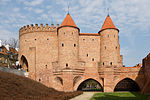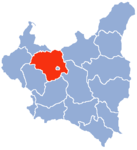Maria Skłodowska-Curie Museum

The Maria Skłodowska-Curie Museum (Polish: Muzeum Marii Skłodowskiej-Curie) is a museum in Warsaw, Poland, devoted to the life and work of Polish two-time Nobel laureate Maria Skłodowska-Curie (1867–1934), who discovered polonium and radium. The Maria Skłodowska-Curie Museum is a cultural institution of The City of Warsaw co-organized by the Polish Chemical Society. It carries out educational and cultural projects related to the Nobel laureate and her family. The museum is located at 16 Freta Street (ulica Freta 16) in Warsaw's "New Town" district (dating from the 15th century), and is housed in the 18th-century tenement house in which Maria Skłodowska was born.Due to renovation, in December 2014 the museum was temporarily moved to 5 Freta Street.
Excerpt from the Wikipedia article Maria Skłodowska-Curie Museum (License: CC BY-SA 3.0, Authors, Images).Maria Skłodowska-Curie Museum
Freta, Warsaw Śródmieście (Warsaw)
Geographical coordinates (GPS) Address Nearby Places Show on map
Geographical coordinates (GPS)
| Latitude | Longitude |
|---|---|
| N 52.251388888889 ° | E 21.008611111111 ° |
Address
Freta 14
00-227 Warsaw, Śródmieście (Warsaw)
Masovian Voivodeship, Poland
Open on Google Maps











